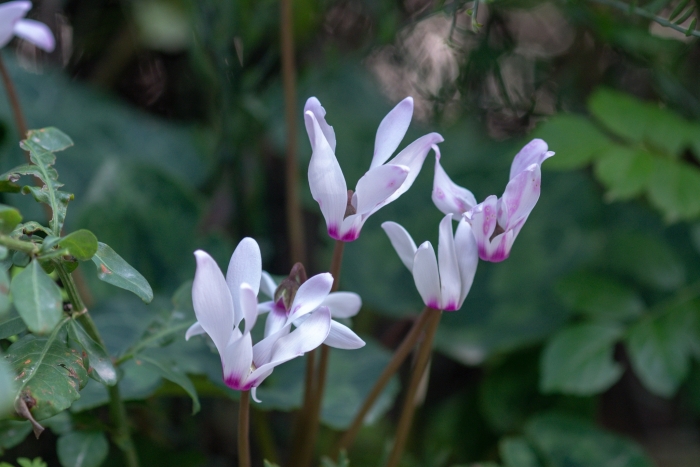Persian Cyclamen
(Cyclamen persicum)
Persian Cyclamen (Cyclamen persicum)
/
/

Dan Killam
CC BY 4.0
Image By:
Dan Killam
Recorded By:
Copyright:
CC BY 4.0
Copyright Notice:
Photo by: Dan Killam | License Type: CC BY 4.0 | License URL: http://creativecommons.org/licenses/by/4.0/ | Rights Holder: Dan Killam | Publisher: iNaturalist | Date Created: 2019-01-22T01:11:46-08:00 |






















































Estimated Native Range
Summary
Cyclamen persicum, commonly known as Persian Cyclamen, is a perennial herb native to rocky hillsides, shrubland, and woodland margins in the Mediterranean region, including countries like Greece, Turkey, and Lebanon. It typically grows to about 32 cm (13 inches) in height. The plant is characterized by its heart-shaped, fleshy leaves that can reach up to 14 cm (6 inches) in length, usually green with lighter marbling on the upper surface. Persian Cyclamen is notable for its flowers, which bloom from winter to spring or in autumn, depending on the climate. The flowers have 5 small sepals and 5 upswept petals, usually white to pale pink with a distinctive band of deep pink to magenta at the base. In the wild, flowers are sweetly scented, but this trait is often not present in cultivated forms. After flowering, the plant goes dormant in summer.
Persian Cyclamen is valued for its ornamental flowers and attractive foliage, making it a popular choice for indoor pot plants, shaded garden beds, and as a seasonal gift plant. It requires careful attention to watering, as it prefers to be kept on the drier side when dormant. The plant thrives in part shade, with medium amounts of water, and well-drained soils. Overwatering, especially during dormancy, can lead to tuber rot. Cyclamen are propagated by seeds and, with good care, can live for 20 to 30 years. They are susceptible to cyclamen mite and fungal diseases such as botrytis, which can be mitigated by proper air circulation and avoiding wet foliage.CC BY-SA 4.0
Persian Cyclamen is valued for its ornamental flowers and attractive foliage, making it a popular choice for indoor pot plants, shaded garden beds, and as a seasonal gift plant. It requires careful attention to watering, as it prefers to be kept on the drier side when dormant. The plant thrives in part shade, with medium amounts of water, and well-drained soils. Overwatering, especially during dormancy, can lead to tuber rot. Cyclamen are propagated by seeds and, with good care, can live for 20 to 30 years. They are susceptible to cyclamen mite and fungal diseases such as botrytis, which can be mitigated by proper air circulation and avoiding wet foliage.CC BY-SA 4.0
Plant Description
- Plant Type: Bulb
- Height: 0.5-0.8 feet
- Width: 0.5-0.8 feet
- Growth Rate: Moderate
- Flower Color: Pink, Purple, Red, White
- Flowering Season: Fall, Spring, Winter
- Leaf Retention: Deciduous
Growth Requirements
- Sun: Part Shade
- Water: Medium
- Drainage: Medium
Common Uses
Bee Garden, Border Plant, Deer Resistant, Fragrant, Groundcover, Potted Plant, Rock Garden, Showy Flowers
Natural Habitat
Rocky hillsides, shrubland, and woodland margins in the Mediterranean region
Other Names
Common Names: Florist’s Cyclamen, Cyklamen, Persisches Alpenveilchen
Scientific Names: , Cyclamen persicum, Cyclamen latifolium, Cyclamen punicum, Cyclamen vernale, Cyclamen albidum, Cyclamen aleppicum, Cyclamen aleppicum subsp. puniceum, Cyclamen antiochium, Cyclamen hederaceum
GBIF Accepted Name: Cyclamen persicum Mill.